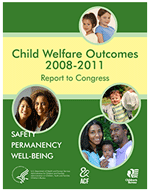
OJJDP Administrator Discusses Juvenile Justice Reform Efforts in NPR Interview

In a recent interview with National Public Radio, Robert L. Listenbee, OJJDP Administrator, discussed priorities for the Office, which include supporting research and programs that promote the safety and well-being of the nation's youth. He spoke about the importance of adopting a trauma-informed approach for treating children exposed to violence and a developmental approach to juvenile justice. He also discussed federal efforts to address the "school-to-prison pipeline."
"We believe firmly that children should be kept in school and out of courts," Listenbee said. "We don't think that kids who are truant, kids who are runaways, kids who engage in various sorts of violations of the code of conduct that aren't criminal offenses—we don't think they belong in the juvenile justice system."
OJJDP Updates Statistical Briefing Book
 OJJDP has updated its Statistical Briefing Book (SBB). Developed by the National Center for Juvenile Justice, SBB offers easy access to a variety of juvenile justice resources. Its data analysis tools allow users to create custom analyses of juvenile populations, arrests, court cases, and residential placements.
OJJDP has updated its Statistical Briefing Book (SBB). Developed by the National Center for Juvenile Justice, SBB offers easy access to a variety of juvenile justice resources. Its data analysis tools allow users to create custom analyses of juvenile populations, arrests, court cases, and residential placements.
The following SBB resources have recently been updated:
Easy Access to Juvenile Populations now includes data through 2012 on national, state, and county population estimates.
Easy Access to the Census of Juveniles in Residential Placement, which provides information such as youth demographics, length of stay, and most serious offense, and Easy Access to the FBI's Supplementary Homicide Reports, which provides victim and offender demographics, now include national and state data through 2011.
Answers to frequently asked questions (FAQs) on juvenile homicide victims and juvenile homicide offenders now include data for 2011. Also available are answers to new FAQs on the Organization & Administration of Delinquency Services.
OJJDP Report Offers Testimonies of Positive Change From Justice-Involved Tribal Youth
Understanding what helps justice-involved tribal youth to make positive changes in their lives and end or reduce their involvement in the tribal juvenile justice system is important for developing effective support from them. This recently released OJJDP report presents perspectives on personal change among justice-involved tribal youth from three tribes that participated in OJJDP's Tribal Juvenile Detention and Reentry Green Demonstration ("Green Reentry") program. The report summarizes past research on risk and protective factors for ongoing justice-system involvement among tribal youth; describes the Green Reentry initiative; and presents the perspectives of youth, parents, program staff, and other stakeholders on experiences of personal change among participating youth.
OJJDP Interviews Students in GWU's Native American Political Leadership Program
In April 2013, then-OJJDP Tribal Youth Justice Fellow Sarah S. Pearson conducted two indepth interviews with young adults (ages 21–26) in George Washington University's Native American Political Leadership Program. The interviews examined the need for more leadership opportunities for high school students in Indian country. To learn more, read Ms. Pearson's article, "Engaging a Powerful Tribal Resource—Tribal Teens: A Candid Conversation with Native American University Students," in the summer 2013 issue of Prevention & Recovery magazine. The magazine is published by the Office of Indian Alcohol and Substance Abuse.
New "Practices" Feature Available at CrimeSolutions.gov
 The Office of Justice Programs' CrimeSolutions.gov, an online resource that uses rigorous research to determine what works in criminal justice, juvenile justice, and crime victim services, has recently added more than a dozen practices to its database. Practice profiles provide valuable information about the average results from multiple evaluations of similar programs, strategies, or procedures. Until now, practitioners looking for evidence of what works in criminal justice often had to rely largely on results from single studies at only one site, which made it difficult to assemble evidence across multiple evaluations of similar programs.
The Office of Justice Programs' CrimeSolutions.gov, an online resource that uses rigorous research to determine what works in criminal justice, juvenile justice, and crime victim services, has recently added more than a dozen practices to its database. Practice profiles provide valuable information about the average results from multiple evaluations of similar programs, strategies, or procedures. Until now, practitioners looking for evidence of what works in criminal justice often had to rely largely on results from single studies at only one site, which made it difficult to assemble evidence across multiple evaluations of similar programs.
Justice Department Releases New PSA on Cyber Security for Kids
Child Cyber Safety Night at the Ballpark on September 21, 2013, was the latest effort by the U.S. Department of Justice (DOJ) and its law enforcement and community partners to encourage parents to speak with their children about online and cell phone safety and to provide prevention materials. As part of the event, DOJ released a new public service announcement in which Attorney General Eric Holder emphasized the importance of creating an ongoing dialogue with children about the safe use of technology. "As a parent, I understand the opportunities—and the challenges—that new technologies present for America's young people. It's up to each of us to start a dialogue with our kids about safe Internet and cell phone practices," said Attorney General Holder. DOJ offered resources for parents and children at the Community Clubhouse at the Center Field Plaza before and during the game. For more on Internet and cell phone safety, please visit the Web site of Project Youth Safety.
National Bullying Prevention Month Observed Nationwide
![]() Communities across the country are recognizing National Bullying Prevention Month this October through special events, activities, outreach, and education. Bullying can be physical, verbal, or social (e.g., rumors and social exclusion). It can happen face to face, in text messages, or on the Web. During the 2010–11 school year, 27.8 percent of students ages 12–18 reported having been bullied at school. Bullying can cause serious and lasting harm, including physical injury, anxiety, depression, and withdrawal from academics and other school activities. In some cases, it has played a role in a young person's suicide.
Communities across the country are recognizing National Bullying Prevention Month this October through special events, activities, outreach, and education. Bullying can be physical, verbal, or social (e.g., rumors and social exclusion). It can happen face to face, in text messages, or on the Web. During the 2010–11 school year, 27.8 percent of students ages 12–18 reported having been bullied at school. Bullying can cause serious and lasting harm, including physical injury, anxiety, depression, and withdrawal from academics and other school activities. In some cases, it has played a role in a young person's suicide.
OJJDP is a member of the Federal Partners in Bullying Prevention, an interagency effort led by the U.S. Department of Education that works to coordinate policy, research, and communications on bullying topics. For more information on how parents, educators, and youth can work together to stop bullying, visit StopBullying.gov. To learn more about the scope of the problem, predictors of bullying, laws against bullying, and evidence-based programs to prevent and intervene in bullying, see OJJDP's Model Programs Guide.
Report Shows Nearly Half of States Are Taking Steps To Remove Youth From the Criminal Justice System
 The Campaign for Youth Justice (CFYJ), a national advocacy organization dedicated to ending the practice of trying, sentencing, and incarcerating youth under 18 in the adult criminal justice system, has released State Trends: Legislative Victories from 2011–2013: Removing Youth from the Adult Criminal Justice System. According to the report, 23 states have enacted 40 pieces of legislation over the past 8 years to reduce the prosecution of youth in adult criminal courts and end the placement of youth in adult jails and prisons. The report also highlights key pieces of legislation enacted between 2011 and 2013.
The Campaign for Youth Justice (CFYJ), a national advocacy organization dedicated to ending the practice of trying, sentencing, and incarcerating youth under 18 in the adult criminal justice system, has released State Trends: Legislative Victories from 2011–2013: Removing Youth from the Adult Criminal Justice System. According to the report, 23 states have enacted 40 pieces of legislation over the past 8 years to reduce the prosecution of youth in adult criminal courts and end the placement of youth in adult jails and prisons. The report also highlights key pieces of legislation enacted between 2011 and 2013.
“We are seeing state policy makers making change based on solid research and public opinion. The research shows that past policies didn't work to increase public safety or reduce juvenile crime,” said Carmen Daugherty, Policy Director for CFYJ. “We now have more evidence on what does work to reduce juvenile crime, which is rehabilitation and treatment over incarceration. Public opinion strongly favors rehabilitation and treatment over incarceration and judicial review over automatic prosecution in adult court.”
International Fetal Alcohol Spectrum Disorders Awareness Day
September 9 was International Fetal Alcohol Spectrum Disorders (FASD) Awareness Day. FASD is an umbrella term for a range of disabilities of varying severity that affect children whose mothers drank alcohol during pregnancy. The disabilities are irreversible, although early diagnosis and treatment can be of considerable help to children with this condition. FASD is the leading known cause of preventable cognitive impairment in the United States. Sixty-one percent of adolescents with FASD have been in legal trouble. Thirty-five percent of those with FASD who are older than age 12 have been incarcerated at some point in their lives. Unfortunately, the vast majority of children with FASD go undiagnosed and untreated.
"We need to be better informed about the factors that dispose these kids to come into contact with the justice system, how to effectively represent these youth in court, and how to most appropriately handle these youth if they should enter the juvenile justice system," said OJJDP Administrator Robert L. Listenbee at a recent OJJDP-sponsored listening session on FASD.
To learn more about how OJJDP and its partnering agencies are working to increase public understanding about the physical, mental, emotional, and behavioral challenges faced by youth with FASD, read the September/October 2012 and July/August 2013 issues of OJJDP News @ a Glance.
National Suicide Prevention Week
 National Suicide Prevention Week (September 8–14) is an annual campaign in the United States to raise national awareness and engage parents, educators, medical personnel, the U.S. military, and mental health and juvenile justice professionals in prevention efforts. Suicide is the 10th leading cause of death for all Americans, the second leading cause of death for adults ages 25–34, and the third leading cause of death for youth ages 15–24. OJJDP strongly supports the National Action Alliance for Suicide Prevention. For the past 2 years, OJJDP co-led the alliance's Task Force for Youth in Contact with the Juvenile Justice System. The National Action Alliance for Suicide Prevention was launched in 2010 by U.S. Department of Health and Human Services Secretary Kathleen Sebelius and former U.S. Department of Defense Secretary Robert Gates. This public-private partnership advances the National Strategy for Suicide Prevention (NSSP) by championing suicide prevention as a national priority, catalyzing efforts to implement NSSP's
high-priority objectives, and cultivating the resources needed to sustain the progress made.
National Suicide Prevention Week (September 8–14) is an annual campaign in the United States to raise national awareness and engage parents, educators, medical personnel, the U.S. military, and mental health and juvenile justice professionals in prevention efforts. Suicide is the 10th leading cause of death for all Americans, the second leading cause of death for adults ages 25–34, and the third leading cause of death for youth ages 15–24. OJJDP strongly supports the National Action Alliance for Suicide Prevention. For the past 2 years, OJJDP co-led the alliance's Task Force for Youth in Contact with the Juvenile Justice System. The National Action Alliance for Suicide Prevention was launched in 2010 by U.S. Department of Health and Human Services Secretary Kathleen Sebelius and former U.S. Department of Defense Secretary Robert Gates. This public-private partnership advances the National Strategy for Suicide Prevention (NSSP) by championing suicide prevention as a national priority, catalyzing efforts to implement NSSP's
high-priority objectives, and cultivating the resources needed to sustain the progress made.
John D. and Catherine T. MacArthur Foundation Launches New Models for Change Resource Center Partnership
 The John D. and Catherine T. MacArthur Foundation has announced that it will commit an additional $15 million to the juvenile justice field, in part to launch a new Models for Change Resource Center partnership. The partnership will provide state and local program administrators, practitioners, and policymakers with technical assistance, training, and the proven tools, resources, and lessons developed through the foundation's Models for Change: Systems Reform in Juvenile Justice initiative. The partnership consists of four complementary, connected resource centers—the Mental Health and Juvenile Justice Collaborative for Change, the National Juvenile Defender Center, the Robert F. Kennedy National Resource Center for Juvenile Justice, and the
Status Offense Reform Center. In addition, several allied organizations that address important juvenile justice issues are involved, including organizations that focus on behavioral health, stronger public defense for poor youth, appropriate interventions for youth charged with nondelinquent offenses, and coordinated systems of care for young people who are involved in both the juvenile justice and child protective systems. The resource centers are scheduled to be operational by the end of 2013.
The John D. and Catherine T. MacArthur Foundation has announced that it will commit an additional $15 million to the juvenile justice field, in part to launch a new Models for Change Resource Center partnership. The partnership will provide state and local program administrators, practitioners, and policymakers with technical assistance, training, and the proven tools, resources, and lessons developed through the foundation's Models for Change: Systems Reform in Juvenile Justice initiative. The partnership consists of four complementary, connected resource centers—the Mental Health and Juvenile Justice Collaborative for Change, the National Juvenile Defender Center, the Robert F. Kennedy National Resource Center for Juvenile Justice, and the
Status Offense Reform Center. In addition, several allied organizations that address important juvenile justice issues are involved, including organizations that focus on behavioral health, stronger public defense for poor youth, appropriate interventions for youth charged with nondelinquent offenses, and coordinated systems of care for young people who are involved in both the juvenile justice and child protective systems. The resource centers are scheduled to be operational by the end of 2013.
Juvenile Justice Resource Hub Adds Alternatives to Detention Section
Developed by the Juvenile Justice Information Exchange and the National Juvenile Justice Network with support from the MacArthur Foundation, the Juvenile Justice Resource Hub provides timely, indepth information on juvenile justice issues and trends. In addition to a section on mental health and substance use disorders, the Hub recently added a section on community-based alternatives for justice system-involved youth. Future Hub topics include indigent defense, evidence-based practices, racial/ethnic disparities, and aftercare.
 Child Welfare Outcomes Report Released
Child Welfare Outcomes Report Released
The Children's Bureau of the U.S. Department of Health and Human Services' Administration for Children & Families has released Child Welfare Outcomes 2008–2011: Report to Congress. This report informs Congress and child welfare professionals about state and national performance on outcome measures for children served by child welfare systems. The outcome measures used in the report focus on seven categories, including children's safety, well-being, and the permanency of their family and living situations.
Series on Trauma-Informed Approach Available Online
The National Child Traumatic Stress Network, a program of the Substance Abuse and Mental Health Services Administration's Center for Mental Health Services, has released six online briefs that discuss the key elements of a trauma-informed juvenile justice system. Topics include current issues and new directions in creating trauma-informed systems, assessment and intervention, family engagement, continuity of care and cross-system collaboration, trauma-informed care in facilities, and racial disparities within the system.